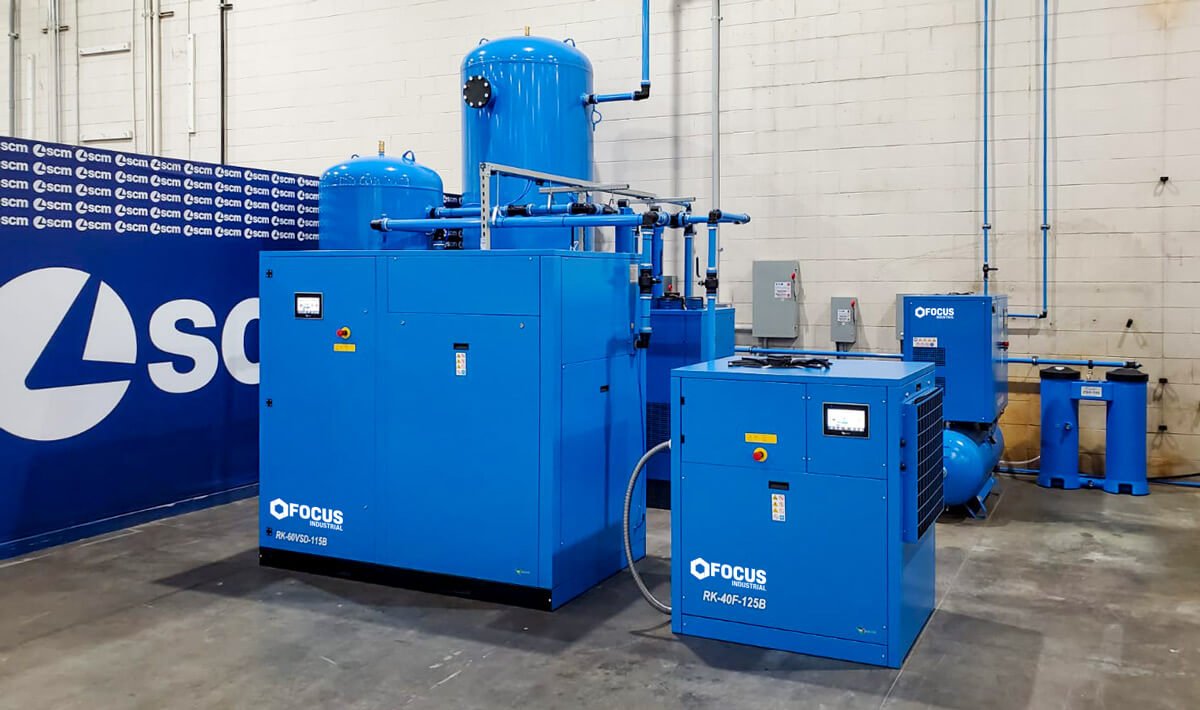Another contributing factor to poor equipment performance is contamination reaching the equipment due to inefficient separation within the pipework system.
The following are ten tips for an efficient compressed air distribution system:
1. Ring Main.
In most cases, efficient compressed air distribution pipe-work incorporating a “ring” or “closed-loop” main pipe are beneficial. Ring main systems allow the air to flow in either direction to get to the point of demand by the path of least resistance. Typically you can multiply the capacity of a straight line distribution main by 1.5 if the same size pipe is made into a closed loop ring main. For example, if a 50mm straight pipe is rated at 500cfm at 125psi, that same pipe in a ring main system would be rated at 750cfm at 125psi.
2. Feeder Pipe
Feed the ring main from a dry compressed air storage tank with a feeder pipe at least one pipe size larger than the ring main itself. This is necessary because, as already explained, the ring main system has 1.5 times the flow capacity of a straight length of pipe and a smaller sized feeder will create a flow restriction at that point.
3. Quick Couplings
Eliminate quick couplings wherever possible. These can restrict flow unnecessarily if not needed. Quick couplings should only be used where quick disconnection of air tools, spray guns or other hand held equipment is required. Any connection of stationary equipment should be by way of hard pipe or flexible hose with straight through barbed fittings and ball valves.
4. Elbows
Avoid the use of elbows, in pipe-work systems wherever possible. Elbows cause the equivalent pressure drop of 1 to 3 metres of pipe depending on the type and size of the fitting. Radius bends have much less flow restriction than elbows. Try to keep pipe-work as straight as possible and avoid the considerable added expense and loss of efficiency resulting from running pipes around columns and roof beams.
5. Future Expansion
If future expansion, or the adding of additional demand, is a possibility, it is much more cost effective to plan for it now compared with the disruption and additional expense of increasing pipe sizes at a later date.
6. Leakage
Any leakage is unacceptable but a totally leak free system is often very time consuming and expensive to achieve in an existing installation. An overnight leak test should not, however, result in a pressure drop of more than 10%. In new installations leak free systems are typically much easier to achieve using aluminium, copper or stainless steel pipe compared with traditional threaded iron systems. Of these alternatives, mechanically swage-jointed stainless steel pipe systems provide very cost effective, durable and leak-free solutions helping provide an efficient compressed air system.
7. Condensate Drainage
Avoid low points in the system that do not have provision for condensate drainage. Low points can cause blockages or restrictions to air flow due to a build-up of contaminants at that point.
8. Drip Leg Drain Drainage
All outlet droppers should have a main isolation ball valve that is reachable from ground level with a drain valve at the bottom of the drip leg for easy removal of contaminants which have dropped past the outlet point.
9. Isolation Valves
Install isolation valves, tees and plugs throughout the main piping system so that potential future expansions and modifications of the systems can be more easily and cost-effectively installed leading to a efficient compressed air system.
10. Dropper Pipes
Dropper pipes do not need to come off the top of the main header pipe and the main header does not need to fall to a corner with a drip leg drain installed. This form of layout is only effective if the header pipe is significantly increased in size to reduce the air velocity and prevent the air from pushing the water along the pipe to where it is going. It is more cost effective to have a drip leg drain at the bottom of each dropper to deal with condensate and contaminants at points in the system where they actually accumulate.
Focus Industrial can advise and quote on the supply and installation of complete efficient compressed air pipe-work systems, as well as the maintenance or replacement of any components in existing systems. For further information please contact us on 1800 763 883.





